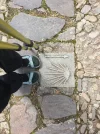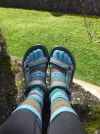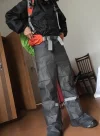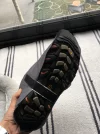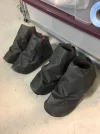D
Deleted member 67185
Guest
Water can enter trail shoes or boots through any opening during a rainstorm or while walking through dew-covered grass or pour into it as happens when you walk through puddles or other standing water along the Camino.
There are two potential remedies to this problem, neither of which is effective. First, you can try keeping rain pants over the tops of shoes, so the water runs down the pants past the opening. But this system is uncomfortably hot in warmer and rainy temperatures, and it offers no protection for puddles or having to cross water runoffs on the pathway.
Or you can try using a shoe with a waterproof gaiter or some other waterproof cobbles -- like thick plastic bags. I have not seen a gaiter or other waterproof type accessory that would both keep the water out, and keep the feet dry.
“Waterproof” shoes fail is because the materials simply don’t work over the near and long term. Lightweight, leather and fabric trail boots, for example, where some manufacturers have tried treating with a coating, don’t last. It also keeps sweat in the shoe and your feet get soaked in sweat. Fairly quickly, coatings break down and will no longer be waterproof.
When I’ve tested so-called waterproof / breathable fabrics in shoes for various manufacturers, their actual performance never matched what was claimed. My reports to their QA departments have always reflected these weaknesses as found during testing.
Waterproof/breathable membranes, like Goretex, are only marginally breathable—water vapor from perspiration does not pass through the fabric as efficiently as is claimed. So on warm days the experience of having sweat being trapped in the shoe is common. Combined with the fact that the fabric waterproofing is quickly damaged by dirt, sweat, grime, and abrasion and it’s only a matter of time before exterior moisture begins penetrating the fabric and allowing feet to get wet.
That’s why serious trekkers and backpackers no longer go to great lengths to keep feet dry. They accept that when the weather is wet, feet will also get wet. Even the US military uses footwear for wet conditions which is not waterproof. The strategy is how to minimize any problems when feet are wet.
More than once, I’ve heard a potential footwear purchaser ask, “Are the shoes / boots waterproof?” “You bet,” is the usual reply... or a variation of same.
A couple of times when I've had the chance, I have asked why they wanted waterproof shoes. Sometimes, the potential buyer will look at me as if I had spaghetti sticking out of my nose. Most will answer that they think their feet will stay dry, and that having wet feet is akin to getting into horrible trouble.
This post is meant to help inform and give a different line of thought and reasoning.
I like to have dry feet. I always try to avoid wet feet. I have tried many ways to keep my feet dry:
1. “Waterproof” shoes, which, as I’ve said, don’t work well.
2. “Waterproof” socks, which don’t work for similar reasons.
3. Wearing multiple pairs of socks, which eventually all get wet.
4. Multiple pairs of shoes, which eventually all get wet too.
Since keeping my feet dry has never worked in very wet conditions, I decided to develop effective strategies so that the bad things that could occur to my wet feet when walking, are either waaaaaay minimized or eliminated. Some of these lessons I learned while in Vietnam…. Like the fact that our boots had fabric tops and numerous holes in the thin leather bottom portions so that water drained out quickly and never sat in the boots.
What are the bad things?
1. Maceration, or pruning, where the skin’s outer layer absorbs and gets “soggy” from moisture. The skin gets sore and extremely soft which makes it more prone to blistering and developing other problems.
2. Cracking of the skin when it dries. The natural moisture and oiliness of the skin is gone. The severity depends on how much stress the skin is exposed to after it is dried out.
So, what does work? For me, if I am going to be walking or backpacking in wet weather:
1. Apply a good coating of salve or balm to my feet before putting on socks and shoes. This helps protect from external moisture.
2. Wear non-waterproof shoes, which drain and dry out quickly. This minimizes the amount of puddling in the shoe that bathes the feet in moisture. Modern trail shoes have nice open mesh fabric which is terrific for draining water.
3. Non-waterproof shoes will also eliminate moisture from sweaty feet. Remember, it doesn’t matter what the source of the moisture is that feet are exposed to; rain or sweat, each can cause the same problems.
4. Wear thin, light-cushioned merino wool socks, which don’t absorb as much water as thicker socks. Merino wool will also keep wet feet warm unless the weather is winter-cold.
5. Take off my shoes and socks to let my feet air dry during any mid-day rest stop that will be longer than 20 minutes. During that time, I will wring out any excess moisture from the socks, but I will not put on either of my dry pairs (I take three). I will also reapply a good amount of balm or salve to my feet to help keep them from becoming macerated.
6. Apply a salve or ointment to the bottoms of my feet when I have stopped for the day both before and after I shower.
7. Carry an extra pair of insoles. These are lightweight and will be the barrier between your wet footwear and your dry socks when you are done for the day and if your shoes are a bit damp come morning.
8. I found that at days end, I can remove the wet insoles and use absorbent paper or toweling to sop up as much moisture as is possible while I am showering and dealing with end of the day chores. Then, when I get ready to go to dinner or wander around town, I put on a pair of dry Merino wool socks, insert the extra pair of dry insoles into my shoes, and put the shoes back on to walk around in. Within a couple of hours, the shoes are mostly dry.
9. At bedtime, I remove the insoles and stuff absorbent material into the shoes to continue the drying out process during the night.
10. Apply more salve or ointment and wear dry and warm socks at night, to give my feet 8-9 hours of recovery time.
There are two potential remedies to this problem, neither of which is effective. First, you can try keeping rain pants over the tops of shoes, so the water runs down the pants past the opening. But this system is uncomfortably hot in warmer and rainy temperatures, and it offers no protection for puddles or having to cross water runoffs on the pathway.
Or you can try using a shoe with a waterproof gaiter or some other waterproof cobbles -- like thick plastic bags. I have not seen a gaiter or other waterproof type accessory that would both keep the water out, and keep the feet dry.
“Waterproof” shoes fail is because the materials simply don’t work over the near and long term. Lightweight, leather and fabric trail boots, for example, where some manufacturers have tried treating with a coating, don’t last. It also keeps sweat in the shoe and your feet get soaked in sweat. Fairly quickly, coatings break down and will no longer be waterproof.
When I’ve tested so-called waterproof / breathable fabrics in shoes for various manufacturers, their actual performance never matched what was claimed. My reports to their QA departments have always reflected these weaknesses as found during testing.
Waterproof/breathable membranes, like Goretex, are only marginally breathable—water vapor from perspiration does not pass through the fabric as efficiently as is claimed. So on warm days the experience of having sweat being trapped in the shoe is common. Combined with the fact that the fabric waterproofing is quickly damaged by dirt, sweat, grime, and abrasion and it’s only a matter of time before exterior moisture begins penetrating the fabric and allowing feet to get wet.
That’s why serious trekkers and backpackers no longer go to great lengths to keep feet dry. They accept that when the weather is wet, feet will also get wet. Even the US military uses footwear for wet conditions which is not waterproof. The strategy is how to minimize any problems when feet are wet.
More than once, I’ve heard a potential footwear purchaser ask, “Are the shoes / boots waterproof?” “You bet,” is the usual reply... or a variation of same.
A couple of times when I've had the chance, I have asked why they wanted waterproof shoes. Sometimes, the potential buyer will look at me as if I had spaghetti sticking out of my nose. Most will answer that they think their feet will stay dry, and that having wet feet is akin to getting into horrible trouble.
This post is meant to help inform and give a different line of thought and reasoning.
I like to have dry feet. I always try to avoid wet feet. I have tried many ways to keep my feet dry:
1. “Waterproof” shoes, which, as I’ve said, don’t work well.
2. “Waterproof” socks, which don’t work for similar reasons.
3. Wearing multiple pairs of socks, which eventually all get wet.
4. Multiple pairs of shoes, which eventually all get wet too.
Since keeping my feet dry has never worked in very wet conditions, I decided to develop effective strategies so that the bad things that could occur to my wet feet when walking, are either waaaaaay minimized or eliminated. Some of these lessons I learned while in Vietnam…. Like the fact that our boots had fabric tops and numerous holes in the thin leather bottom portions so that water drained out quickly and never sat in the boots.
What are the bad things?
1. Maceration, or pruning, where the skin’s outer layer absorbs and gets “soggy” from moisture. The skin gets sore and extremely soft which makes it more prone to blistering and developing other problems.
2. Cracking of the skin when it dries. The natural moisture and oiliness of the skin is gone. The severity depends on how much stress the skin is exposed to after it is dried out.
So, what does work? For me, if I am going to be walking or backpacking in wet weather:
1. Apply a good coating of salve or balm to my feet before putting on socks and shoes. This helps protect from external moisture.
2. Wear non-waterproof shoes, which drain and dry out quickly. This minimizes the amount of puddling in the shoe that bathes the feet in moisture. Modern trail shoes have nice open mesh fabric which is terrific for draining water.
3. Non-waterproof shoes will also eliminate moisture from sweaty feet. Remember, it doesn’t matter what the source of the moisture is that feet are exposed to; rain or sweat, each can cause the same problems.
4. Wear thin, light-cushioned merino wool socks, which don’t absorb as much water as thicker socks. Merino wool will also keep wet feet warm unless the weather is winter-cold.
5. Take off my shoes and socks to let my feet air dry during any mid-day rest stop that will be longer than 20 minutes. During that time, I will wring out any excess moisture from the socks, but I will not put on either of my dry pairs (I take three). I will also reapply a good amount of balm or salve to my feet to help keep them from becoming macerated.
6. Apply a salve or ointment to the bottoms of my feet when I have stopped for the day both before and after I shower.
7. Carry an extra pair of insoles. These are lightweight and will be the barrier between your wet footwear and your dry socks when you are done for the day and if your shoes are a bit damp come morning.
8. I found that at days end, I can remove the wet insoles and use absorbent paper or toweling to sop up as much moisture as is possible while I am showering and dealing with end of the day chores. Then, when I get ready to go to dinner or wander around town, I put on a pair of dry Merino wool socks, insert the extra pair of dry insoles into my shoes, and put the shoes back on to walk around in. Within a couple of hours, the shoes are mostly dry.
9. At bedtime, I remove the insoles and stuff absorbent material into the shoes to continue the drying out process during the night.
10. Apply more salve or ointment and wear dry and warm socks at night, to give my feet 8-9 hours of recovery time.
Last edited by a moderator:














